Keeping Your Cat Calm and Quiet on a Plane
When a cat meows, yowls, or hisses on a plane, it's not being bad. It is showing you that it's scared and stressed. The new sounds, smells, and being stuck in a small space can feel very threatening to them.
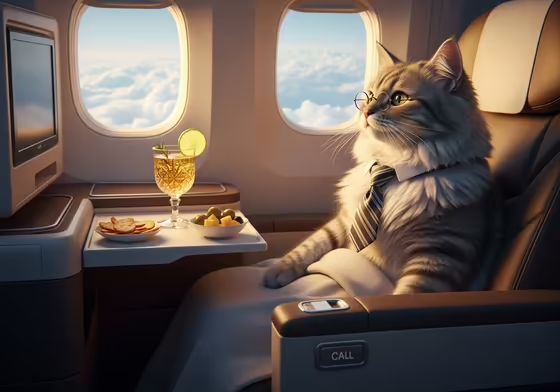
Your job isn't just to make them quiet, but to help them feel less anxious. Many people worry that flying is cruel to cats. Vets agree that while most cats find travel stressful , it's not cruel if you prepare correctly.
Getting ready ahead of time helps both you and your cat. Cats can tell when you're nervous , which makes them think something is wrong. If you feel prepared and calm, your cat will feel safer too.
How to Get Ready Before Your Flight
Getting things ready weeks before your trip is the best way to make sure the flight goes smoothly. These next steps are important and should be started long before your travel date.
Talk to Your Vet First
Before you do anything else, you need to talk to your vet. This is the most important step for making sure your cat is safe and ready to fly.
You should schedule a visit with your vet before your trip, especially if you're flying to another country. An accredited vet can help with the extra paperwork.
Here's what you need to talk about:
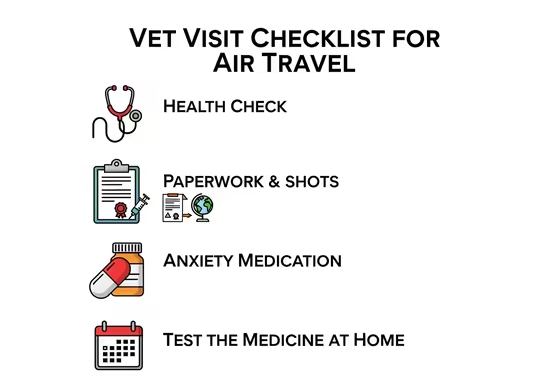
- Health Check: The vet needs to make sure your cat is healthy enough for the stress of flying. This is extra important for older cats, short-nosed breeds like Persians, or cats with heart or breathing problems. Flying can make existing health issues worse.
-
Paperwork and Shots:
You will get all the required travel documents at this visit.
- Health Certificate: Most airlines require a health certificate from your vet. This paper says your cat is healthy enough to travel and usually needs to be issued within 10 days of your flight.
- Vaccinations: Your vet will make sure your cat's shots are up to date. Airlines almost always require a rabies vaccine and other standard shots.
- International Travel: Flying to another country has more complex rules that you need to start months ahead of time. You might need special tests, a microchip, and official government stamps on your paperwork.
- Medicine for Anxiety: This is the key to a quiet flight. Ask your vet for anti-anxiety medicine, not a sedative. Good options to ask about are Gabapentin or Trazodone .
- Test the Medicine: Your vet will tell you to give your cat a test dose at home before you travel. This makes sure the medicine works and doesn't cause a bad reaction.
A vet visit is stressful for most cats. You can use this to your advantage. Give your cat the test dose of medicine before you go to the vet.
This does three things. It tests how well the medicine works in a stressful situation. It makes the vet visit easier for everyone.
Your vet can also see how the cat reacts to the medicine and can adjust the dose if needed. This helps you get the plan right long before your flight.
Help Your Cat Get Used to the Carrier
If your cat is scared of its carrier, the trip will start off with a lot of stress. You need to change how your cat feels about the carrier. The goal is to make it a safe space instead of a scary box.
Here’s how to get your cat comfortable with the carrier:
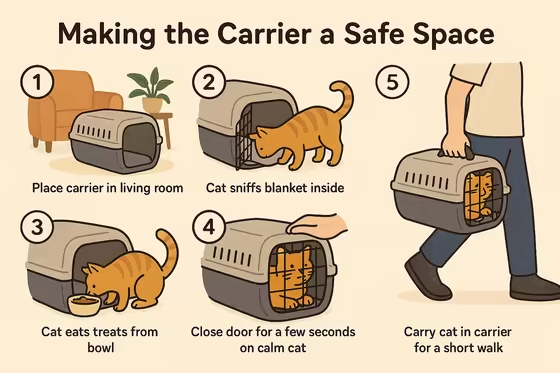
-
Choose the Right Carrier:
- Type: You need a soft-sided carrier for flying in the cabin. It can squish down to fit under the seat, which a hard carrier can't do.
- Size: Check your airline's website for the maximum size allowed under the seat before you buy a carrier. A carrier that is too big might not be allowed on the plane. Your cat should be able to stand up and turn around inside.
- Features: Look for good ventilation and locking zippers so your cat can't escape.
-
Help Your Cat Like the Carrier:
- Make it normal: Weeks before your trip, leave the carrier out in your living room with the door open. Let it become a normal piece of furniture that isn't scary.
- Make it comfy: Put your cat's favorite blanket or one of your unwashed t-shirts inside. This makes it smell familiar and safe.
- Add good things: Start feeding your cat near the carrier. Then, move the food bowl just inside the door, and then all the way inside. Give them special treats that they only get inside the carrier.
- Practice closing the door: Once your cat goes in willingly, start closing the door for just a few seconds, then open it and give a treat. Slowly make the time longer.
- Practice moving: Once your cat is calm inside with the door closed, pick up the carrier and walk around. Then, take short car rides that don't end at the vet to break that bad connection.
- Make it Comfortable for Travel: On travel day, line the carrier with a familiar blanket and an absorbent pee pad. You can also use a calming spray like Feliway, which uses pheromones that signal safety to cats. Spray it 30 minutes before putting your cat inside, and never spray it directly on your cat.
The Day Before You Fly
The day before your flight is about managing your cat’s food and water and packing your carry-on bag. This will help reduce discomfort during the flight.
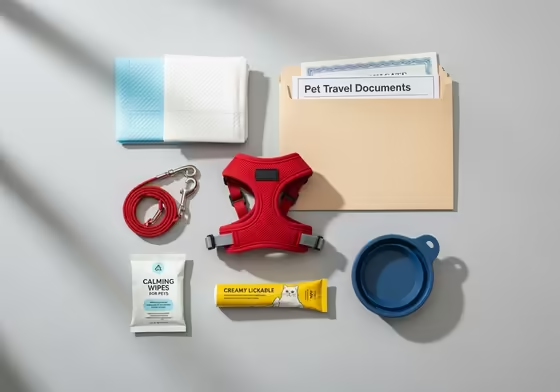
-
Food and Water:
- Food: Vets and airlines recommend you stop feeding your cat 4-6 hours before the flight. This reduces the chance of them getting sick or needing to use the bathroom on the plane.
- Water: Let your cat drink water right up until you leave for the airport. It's important they stay hydrated.
-
Your Cat's Carry-On Checklist:
Pack a small bag with everything you'll need during the flight.
- Pee Pads: Line the carrier with one and pack a few extras.
- Harness and Leash: You will need this to get through airport security safely.
- Calming Wipes: These can be useful for small cleanups or refreshing the carrier.
- Special Treats: Pack a few lickable treats. They are great for distracting your cat and helping their ears with pressure changes.
- Water Dish: A small, collapsible bowl is good for long flights or delays.
- Paperwork: Keep the original health certificate and vaccination records with you.
Should You Give Your Cat Medicine?
This is one of the most important things to understand. There's a big difference between safe anti-anxiety medicine and dangerous sedatives. Getting this wrong can be a serious mistake.
Always Talk to a Vet First
Never give your cat medication without talking to a vet first. Using human medicines on your own is very dangerous for your cat.
- The Problem with Benadryl: Do not give your cat Benadryl without your vet's okay. It can sometimes cause the opposite of what you want. Instead of calming your cat, it can make them hyper, agitated, and even louder , which would be terrible on a plane.
-
The Dangers of Sedatives:
- Why They're Risky: Vets and airlines strongly advise against using sedatives for flights. These drugs can cause a dangerous drop in blood pressure and slow down breathing. These side effects get much worse in the low-oxygen air of a plane cabin.
- Other Dangers: Sedatives also make it hard for a cat to balance or control its body temperature. A sedated cat can't brace itself during turbulence and could get hurt.
A sedative like Acepromazine basically paralyzes your cat without getting rid of the fear. Your cat might look calm, but it could be awake, terrified, and unable to react . This can make the flight even more scary for them.
A safe flight needs a cat that is free from anxiety but still able to react normally. A heavily sedated cat is a medical risk.
Safe Medicine Your Vet Might Suggest
Modern vets use medicines that reduce anxiety without heavy sedation. These are the best and safest choices for air travel.
-
Gabapentin:
- What it does: This is an anti-anxiety medicine that also helps with pain. It's a top choice for vets because it's safe and works well.
- How to use it: You need to give it to your cat 90 to 180 minutes before you leave for the airport. It might make your cat sleepy or a little wobbly, which is normal and safe for travel.
-
Trazodone:
- What it does: This medicine works by increasing serotonin , a chemical in the brain that helps with mood. It makes cats feel relaxed and sleepy.
- How to use it: It should be given 90-120 minutes before the flight. Sometimes vets prescribe it along with Gabapentin for very anxious cats.
-
Buprenorphine:
- What it does: This is mainly a strong painkiller, but it's also used to reduce stress because of its calming effects . It often comes as a liquid that you can give on the gums, which is easier than a pill.
- Remember the Trial Dose: You must test any medicine at home first. This is the only way to know if the dose works and that your cat won't have a bad reaction.
| Feature | Gabapentin | Trazodone |
|---|---|---|
| Main Job | Reduces anxiety and helps with pain | Reduces anxiety |
| What Vets Think | Often the first choice ; it works well and is very safe. | Works well; sometimes used with Gabapentin . |
| Typical Dose | 50-200 mg per cat. | 25-100 mg per cat. |
| When to Give It | Give 90-180 minutes before you leave. | Give 90-120 minutes before you leave. |
| Main Benefit | Reduces anxiety without making them too sleepy. | Works well for anxiety and often makes them sleepy. |
| Possible Side Effects | Sleepiness, being a little wobbly. | Sleepiness, maybe an upset stomach. |
Natural Calming Options
For cats that are only a little nervous, some non-prescription options might help. They can also be used with other methods to reduce stress.
-
Pheromones (Feliway):
- How it works: These products are not drugs. They are copies of a chemical cats release from their cheeks when they feel safe and rub on things.
- How to use it: Using Feliway spray or wipes in the carrier can make your cat feel more secure.
-
Supplements:
- Zylkene: This supplement comes from a protein in milk and is thought to copy the calm feeling kittens get when nursing. It can help with mild stress.
- L-theanine: This is an amino acid found in green tea that can help reduce anxiety in cats .
-
Herbal Remedies:
- Be Careful: You should be careful with herbal options like chamomile or valerian root.
- The Risk: These products are not regulated like medicines, so doses can be inconsistent. There isn't much research on how safe they are for cats. You should always talk to your vet before using them.
For something simple like getting new furniture, natural aids are a good first step. But for the major stress of a plane ride, they are not enough on their own. Relying only on a Feliway spray for a very anxious cat will probably not work.
The best plan is to combine methods. Use vet-prescribed medicine to manage the main anxiety, train your cat to see the carrier as a safe space, and add a Feliway spray for extra comfort.
What to Do on the Day of Your Flight
This is a step-by-step guide for getting through the airport with your cat.
Getting Through the Airport
The security checkpoint is the most likely place for a cat to escape. You need to handle this part carefully.

- Put the Harness On First: Before you even get in the security line, your cat must be in a well-fitted harness with a leash attached. Hold the leash securely at all times.
-
What to Expect at TSA:
- You cannot send your cat through the X-ray machine.
- You have to take your cat out of the carrier .
- The empty carrier will go through the X-ray machine.
- You will carry your cat through the human metal detector.
- The Safest Way: Ask for a Private Screening: The normal security process is loud, crowded, and scary for a cat. A scared cat might try to run.
You have the right to ask for a private screening room , and this is the safest way to go.
Here's what to do. When you get to the checkpoint, tell the first TSA officer, "I am traveling with a cat and I request a private screening room."
They will take you to a small room with a closed door. Inside, you can safely take your cat out of the carrier while they screen it. This prevents any chance of escape.
Getting on the Plane
Getting your cat settled in for the flight is the next key step.
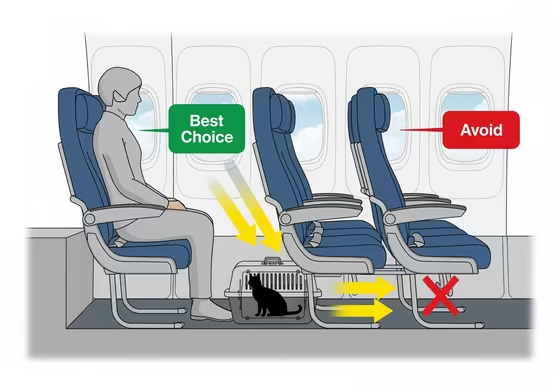
- Pick the Best Seat: A window seat is the best choice . The carrier has to stay under the seat in front of you. An aisle seat exposes the carrier to being kicked or bumped by people and carts, while a window seat creates a protected corner for your cat.
- Place the Carrier Correctly: Put the carrier under the seat in front of you, never in the overhead bin. Make sure the vents are not blocked.
- Block the View: Drape a lightweight, breathable blanket over the carrier. This blocks out the scary sights and sounds of the plane and helps the carrier feel more like a safe, dark den. Make sure there is still plenty of airflow.
How to Keep Your Cat Calm During the Flight
Once you're in the air, your calm behavior is the best tool to help your cat.
- Be Calm: Your cat will follow your lead. Speak in a low, soothing, and calm voice. Avoid high-pitched "it's okay!" chatter, which can sound like an alarm to a cat.
- Use Touch: If your cat likes it, you can stick a single finger through a secure part of the carrier for them to sniff or rub against. Do not open the carrier or take your cat out.
- Understand Their Meows: Try to tell the difference between a truly scared yowl and an attention-seeking meow . A scared cry should be soothed with your voice. But if your cat is just meowing to be let out, giving it attention can make the behavior worse.
- Use Calming Wipes: If your cat seems stressed, you can use a calming wipe on the bedding inside the carrier. This can refresh the "safe" smell in their space.
| What's Happening | What to Do | Why It Works |
|---|---|---|
| Takeoff & Landing (Loud crying) | Offer a lickable treat. | This makes them swallow , which "pops" their ears and relieves painful pressure. |
| Constant, Anxious Yowling | Drape a breathable blanket over the carrier. | Blocks scary sights and makes the carrier feel like a safe, dark den. |
| Restless or Scratching | Check airflow and temperature. Speak in a low, calm voice. | Makes sure they are physically comfortable and reassures them. |
| Panting | Serious. Immediately check for good airflow and make sure the cat is not too hot. | Panting is a sign of extreme stress or overheating in cats. |
Fixing Common Problems on the Plane
Sometimes a cat is making noise because it's physically uncomfortable. Fixing these issues is often the quickest way to quiet them down.
Helping with Ear Pain
This is a common and painful reason for a cat to cry on a plane, but it's often overlooked.
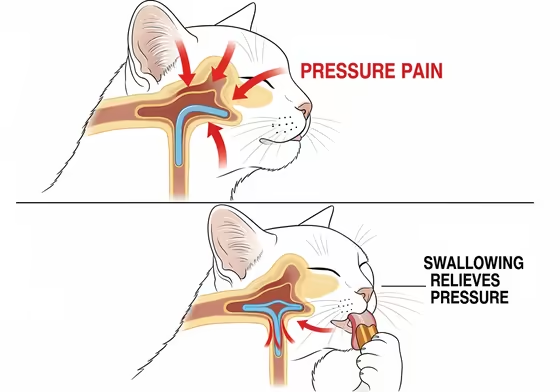
So, do cats' ears hurt when flying? The answer is YES. Just like people, cats have tubes in their ears that are affected by pressure changes. This can be very painful for them .
If your cat was calm but starts crying during takeoff or landing, it's very likely because their ears hurt.
To fix this, you need to make them swallow. Swallowing is what "pops" the ears and gets rid of the pressure. The best way to do this is to offer a lickable treat or a little water on your finger.
What About a Litter Box?
Many owners worry about this, but it's usually simple to manage.
For most flights under 8 hours, you don't need a litter box. The pre-flight fast helps reduce their need to go. The best solution is to line the carrier with absorbent pee pads and pack a few extras.
A healthy cat can hold its pee for 24-48 hours if needed. The bigger risk is an accident caused by stress. A calm cat is much less likely to have a stress-related accident.
For long flights over 8-10 hours, you can offer a bathroom break. Take the whole carrier into the airplane bathroom, where it's private and your cat can't escape. Inside, you can set up a small, disposable litter box and give your cat a chance to use it.
Common Questions About Flying with a Cat
Here are quick answers to some common last-minute questions.
What are the main signs of cat anxiety on a plane?
Look for these common stress signals:

- Noises: This is the easiest to spot. It includes lots of meowing, loud yowling, or hissing.
- Body Language: Shaking, drooling, and wide pupils are common signs.
- Behavior: Trying hard to escape the carrier, or the opposite, freezing in place.
- Accidents: Urinating or defecating due to stress.
- CRITICAL SIGN: Panting. Panting is not normal for a cat . It's a sign of extreme stress or overheating. If you see this, immediately check the carrier's airflow and make sure your cat is not too hot.
What can I do if my cat won't stop meowing on the plane?
Here is a quick checklist of what to do:
- Check for Pain: If it's takeoff or landing, their ears probably hurt. Offer a lickable treat to make them swallow.
- Block Their View: Drape a breathable blanket over the carrier to create a dark, safe space.
- Check Comfort: Make sure they have good airflow and that their pee pad is clean.
- Soothe Them: Talk in a low, calm voice.
- Do Not: Do not take your cat out of the carrier. It's against airline rules and is very unsafe.
Is it okay to sedate a cat for a plane ride?
The answer is NO. This is a very important safety warning. Most vets and all airlines advise against heavily sedating pets for travel.
Heavy sedation is dangerous. It can affect your cat's breathing, body temperature, and balance in the high-altitude cabin.
The goal is not a knocked-out cat, but a calm one. This is done safely with the plan in this guide: getting them used to the carrier, using calming pheromones, and giving them vet-prescribed anti-anxiety medicine.